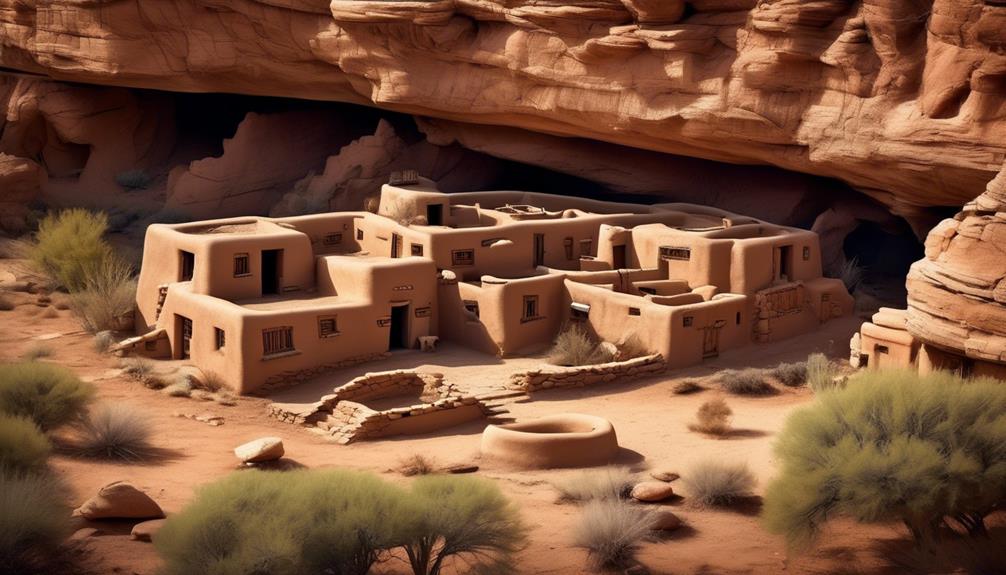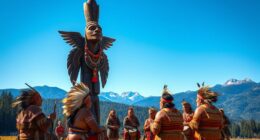The Hopi Tribe, situated in Northern Arizona, is well-known for its long-standing traditions and vibrant cultural legacy. Exploring the tribal lands and visiting its diverse villages will unveil a distinctive mix of history and modernity that distinguishes this community.
But it's not just the villages that define the Hopi way of life; it's also the natural surroundings, the mesas, canyons, and desert landscapes that form the backdrop to their existence. And as we delve deeper into their traditional way of life, we will discover the profound connection between the Hopi people, their agricultural practices, and spiritual beliefs.
However, there are also challenges that the Hopi face in upholding their ancestral lands, and their resilience in the face of these challenges is truly inspiring.
Key Takeaways
- The Hopi Reservation and Villages are located in northeastern Arizona and are known for upholding beliefs, traditions, and customs.
- The preservation of ancient ceremonies and traditional crafts is a priority for the Hopi people, as they strive to pass down ancestral wisdom to younger generations.
- The Hopi have a deep connection between their agricultural practices and spiritual beliefs, viewing them as intertwined aspects of their way of life.
- The villages of Walpi, Oraibi, and Hotevilla serve as centers for cultural preservation, safeguarding traditional practices, ceremonies, and art forms.
Hopi Reservation: A Land of Tradition and Heritage
Why do the Hopi people consider their reservation a land of tradition and heritage?
The Hopi reservation isn't just a geographical area; it's the heart of their cultural preservation. Nestled in northeastern Arizona, the reservation is a place where the Hopi people have lived for centuries, upholding their beliefs, traditions, and customs.
The reservation life revolves around the preservation of ancient ceremonies, traditional crafts, and the teaching of ancestral wisdom to the younger generations. It's a land where the past intertwines with the present, where the spirits of ancestors echo through the red rock mesas and the adobe villages.
The reservation is a tapestry of history, where every stone and every step carry the weight of tradition. It's a place where the rhythm of life follows the cycles of nature, where planting and harvest seasons aren't just agricultural events, but spiritual ceremonies deeply ingrained in the Hopi way of life.
The land itself is sacred, and every hill, spring, and valley holds stories of creation and resilience. The Hopi reservation is a living museum of tradition and heritage, where the spirit of the Hopi people continues to thrive amidst the challenges of the modern world.
Hopi Villages: Cultural Diversity and History

Nestled among the mesas and valleys of northeastern Arizona, the Hopi villages embody a rich tapestry of cultural diversity and historical significance. Each village, including Walpi, Oraibi, and Hotevilla, holds a unique place in the Hopi people's heritage. The villages aren't just physical locations but living testaments to the resilience and perseverance of the Hopi tribe. They serve as centers for cultural preservation, where traditional practices, ceremonies, and art forms are safeguarded and passed down through generations. The architectural layout of the villages reflects the deep-rooted traditions and spiritual beliefs of the Hopi people, with each building and plaza holding symbolic significance.
Tribal sovereignty is a keystone in the preservation of the Hopi villages. The Hopi Tribe has the authority to govern and make decisions about their land, resources, and cultural practices. This sovereignty empowers the Hopi people to protect their villages and heritage, ensuring that their way of life continues undisturbed by external influences. Through this autonomy, the Hopi people can continue to thrive within their villages, maintaining their cultural identity and historical connections to the land.
Natural Surroundings: Mesas, Canyons, and Desert Landscapes
The Hopi villages are surrounded by a breathtaking natural landscape, characterized by majestic mesas, intricate canyons, and expansive desert vistas.
The towering mesas, such as First Mesa, Second Mesa, and Third Mesa, aren't only stunning geographical features but also hold deep cultural significance for the Hopi people. These mesas are home to the traditional Hopi villages, where the Hopi have maintained their traditional way of life for centuries.
The canyons, like the famous Grand Canyon, which isn't far from the Hopi lands, provide both natural beauty and a connection to the ancestral lands of the Hopi tribe.
The vast desert landscapes that stretch across the Hopi reservation aren't only visually stunning but also integral to the Hopi way of life, providing the resources and space necessary for their agricultural practices and ceremonial traditions.
Traditional Way of Life: Agriculture and Spiritual Practices

Embracing the harmony between our agricultural traditions and spiritual practices, the Hopi people cultivate a deep connection to the land and the spiritual forces that guide their way of life. Our agricultural techniques are rooted in centuries-old wisdom, allowing us to sustainably farm in the arid desert environment. Through terraced farming, we harness the limited water sources efficiently, nurturing our crops of corn, beans, and squash.
The ceremonial rituals associated with planting, growing, and harvesting are integral to our agricultural practices. These rituals not only honor the land and the deities but also serve as a way to pass down traditional knowledge from one generation to the next.
Our spiritual practices are intricately woven into our agricultural way of life. As we cultivate the land, we do so with reverence, recognizing the interconnectedness of all living beings. Ceremonial dances and prayers are performed to express gratitude for the earth's bounty and to seek blessings for a bountiful harvest. Each step in the agricultural process is infused with spiritual significance, fostering a profound respect for the land and a deep sense of responsibility to care for it.
This holistic approach to agriculture and spirituality reflects our commitment to serve the land and honor the spiritual forces that shape our existence.
Upholding Ancestral Lands: Challenges and Resilience
Upholding our ancestral lands amidst modern challenges demands unwavering resilience and dedication, as we navigate the complexities of preserving our heritage in the face of external pressures and encroachments. Our commitment to protecting our land rights is a fundamental aspect of our identity as the Hopi Tribe. The challenges we face are multifold, ranging from environmental threats to legal disputes over land ownership. However, our resilience is unwavering, and we're bolstered by the unwavering support of our community.
- Environmental Threats: Our lands face numerous environmental challenges, including erosion and water scarcity, which directly impact our ability to maintain traditional agricultural practices.
- Legal Disputes Over Land Ownership: The assertion of our land rights often involves navigating complex legal frameworks, and we frequently encounter disputes over ownership and usage rights.
- Resilience: Despite the challenges, our community remains steadfast in its dedication to upholding our ancestral lands, drawing strength from our deep spiritual connection to the land.
- Community Support: The support of our fellow community members is a vital source of resilience, empowering us to stand firm in the face of external pressures and uncertainties.
Frequently Asked Questions
What Is the Population of the Hopi Tribe and How Has It Changed Over Time?
The population changes of the Hopi Tribe over time have been influenced by various demographic trends, economic development, and cultural exchanges. These factors have impacted the tribe's size and composition, leading to fluctuations in population numbers.
As a result, the tribe has experienced shifts in its community makeup and social dynamics. These changes reflect the complex interplay of historical, social, and economic forces shaping the Hopi Tribe's population.
What Are the Main Sources of Income for the Hopi Tribe?
Main sources of income for the Hopi Tribe include farming, arts, and crafts. Economic activities center around cultivating corn, beans, and squash, vital to their sustenance and cultural traditions.
Additionally, the tribe's renowned artisans produce exquisite pottery, kachina dolls, and intricate textiles, generating revenue from sales and tourism.
These activities not only provide economic stability but also preserve the tribe's heritage, ensuring the continuation of their unique way of life.
How Does the Hopi Tribe Govern Itself and What Is Its Political Structure?
We have a rich political organization that has been a cornerstone of our community for centuries. Traditional leadership, rooted in our cultural heritage, plays a pivotal role in governing the Hopi Tribe.
Our political structure is deeply intertwined with our spiritual beliefs and traditions, guiding decision-making and fostering unity. This unique system has sustained our community, ensuring the preservation of our values and way of life.
What Are Some Significant Historical Events or Conflicts That Have Shaped the Hopi Tribe's Identity and Culture?
Significant historical conflicts and cultural influences have profoundly impacted identity and traditional practices.
These events have shaped our tribe's rich history, fostering a deep connection to our heritage and values.
The impact of these historical events continues to resonate within our community, influencing our cultural practices and shaping our collective identity.
These experiences have contributed to the resilience and strength of our tribe, symbolizing the enduring spirit of our people.
How Does the Hopi Tribe Interact With Neighboring Native American Tribes or Other Communities in the Region?
In our region, intertribal relations are crucial for cultural exchange and mutual support. We interact with neighboring Native American tribes and communities through ceremonies, trade, and alliances.
Our connections foster a rich tapestry of traditions, beliefs, and practices that strengthen our collective identity. These interactions promote understanding and cooperation, enhancing the interconnectedness of our communities.
Our shared history and ongoing exchanges create a vibrant network that sustains and enriches our cultural heritage.
Conclusion
In the heart of the American Southwest, the Hopi Reservation stands as a testament to the enduring spirit of a people deeply rooted in tradition and heritage. Surrounded by mesas, canyons, and desert landscapes, their villages and way of life are a living testament to their resilience and connection to the land.
Upholding their ancestral lands, the Hopi tribe continues to face challenges with unwavering strength, embodying the strength of the desert winds and the wisdom of the ancient earth.









